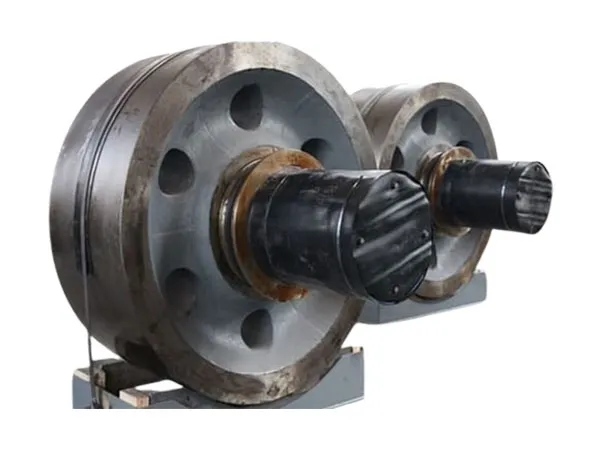- +86 13837949030 +86 15890619536
- info@lymcbearings.com export@lymcbearings.com
- Luoxin Industrial Cluster, Luoyang City,Henan Province,China

Support rollers are mechanical components used to support and guide moving parts in various systems, ensuring smooth and efficient operation. They are commonly found in conveyor systems, machinery, and industrial equipment where they assist in the movement and alignment of components. Typically cylindrical or drum-shaped, made from materials such as steel, aluminum, or plastic. The choice of material depends on the application’s load requirements and operating conditions. Support rollers often include bearings that allow the roller to rotate smoothly with minimal friction. The type of bearing used (e.g., ball bearings, roller bearings) affects the roller's performance and lifespan. The roller is mounted on a shaft, which is supported by brackets or frames. The shaft allows the roller to rotate freely. Support rollers are essential components in many mechanical systems, providing stability, guidance, and support for moving parts. Proper selection, installation, and maintenance are key to ensuring their optimal performance and longevity.
Support rollers are critical components used in various types of heavy machinery and equipment to support rotating parts such as kilns, rotary dryers, and mills. These rollers bear the weight of the rotating equipment and ensure smooth, stable operation by providing support and minimizing friction during rotation. Support rollers are designed to handle substantial loads, maintain alignment, and reduce wear, contributing to the longevity and efficiency of the equipment.
Cylindrical Design: Support rollers are typically cylindrical in shape, with a smooth outer surface that provides a stable base for rotation.
Material: Made from high-strength materials such as alloy steel, cast steel, or ductile iron to withstand heavy loads, high temperatures, and continuous operation.
Bearing Support: Equipped with bearings or bushings to minimize friction between the roller and the shaft, ensuring smooth rotation and reducing wear.
Surface Hardening: The surface of support rollers is often hardened or coated to resist wear and extend their service life, especially in high-load applications.
Mounting: Typically mounted on robust support structures or frames that ensure proper alignment and stability.
Support rollers function by supporting the weight of rotating equipment and enabling smooth rotation. In large equipment like rotary kilns and dryers, the rollers are mounted on shafts and positioned under the rotating shell. The weight of the shell and its contents rests on these rollers. As the shell rotates, the rollers provide continuous support, allowing the equipment to turn smoothly while maintaining alignment.
The rotation of the equipment generates friction between the shell and the rollers, which is minimized by the bearings or bushings in the rollers. Proper alignment and maintenance of support rollers are crucial to ensure uniform load distribution, reduce wear, and prevent premature failure.
Rotary Kilns:
Application: Support rollers are extensively used in rotary kilns in industries such as cement, lime, and metallurgy. They support the rotating kiln shell, ensuring smooth and consistent rotation during the production process.
Function: Bear the weight of the kiln and its contents, maintain alignment, and reduce wear.
Rotary Dryers:
Application: Used in rotary dryers for drying bulk materials such as minerals, chemicals, and aggregates. The rollers support the rotating drum, allowing for continuous drying.
Function: Provide support and enable smooth rotation of the drum while minimizing friction.
Ball Mills and Grinding Mills:
Application: Support rollers are used in ball mills and grinding mills for the comminution of ores, minerals, and other materials.
Function: Support the rotating mill shell, reduce friction, and prevent misalignment.
Conveyors and Bulk Material Handling:
Application: Used in heavy-duty conveyors and bulk material handling equipment to support and guide the rotating belts or drums.
Function: Ensure smooth and efficient operation of the conveyor system.
Mining and Metallurgical Equipment:
Application: Found in various types of mining and metallurgical equipment where support for heavy rotating parts is required.
Function: Provide stability, reduce wear, and maintain alignment of the rotating components.
Stability and Load Distribution: Support rollers provide stable support for rotating equipment, ensuring uniform load distribution and reducing stress on the system.
Reduced Wear and Friction: Equipped with high-quality bearings or bushings, support rollers minimize friction, reducing wear and extending the life of both the rollers and the rotating equipment.
Durability: Made from high-strength materials with surface hardening or coating, support rollers are highly durable and can withstand harsh operating conditions, high temperatures, and heavy loads.
Ease of Maintenance: Designed for easy access and maintenance, allowing for regular inspection, lubrication, and replacement when needed.
Alignment Control: Properly aligned support rollers prevent misalignment of rotating equipment, reducing the risk of mechanical failure and downtime.
Design Considerations for Support Rollers
Material Selection: The material must be chosen based on the operating environment, load capacity, and temperature conditions to ensure durability and performance.
Bearing Selection: Bearings or bushings should be selected based on the load, speed, and operating conditions to minimize friction and wear.
Surface Hardness: The surface of the roller should be hardened or coated to resist wear, especially in high-load and high-temperature applications.
Alignment and Mounting: Proper alignment and secure mounting are essential to ensure even load distribution and prevent misalignment.
Lubrication and Cooling: Adequate lubrication is necessary to reduce friction and heat generation, extending the life of the rollers and bearings.